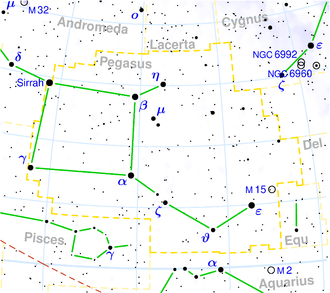NGC 7688
| Galaxie NGC 7688 | |
|---|---|
 | |
| SDSS-Aufnahme | |
| AladinLite | |
| Sternbild | Pegasus |
| Position Äquinoktium: J2000.0, Epoche: J2000.0 | |
| Rektaszension | 23h 31m 05,5s[1] |
| Deklination | +21° 24′ 41″ [1] |
| Erscheinungsbild | |
| Morphologischer Typ | S0 [1] |
| Helligkeit (visuell) | 14,5 mag [2] |
| Helligkeit (B-Band) | 15,5 mag [2] |
| Winkelausdehnung | 0,4' × 0,3' [2] |
| Positionswinkel | 95° [2] |
| Flächenhelligkeit | 12,1 mag/arcmin² [2] |
| Physikalische Daten | |
| Rotverschiebung | 0.038016 ± 0.000103 [1] |
| Radialgeschwindigkeit | (11397 ± 31) km/s [1] |
| Hubbledistanz vrad / H0 | (517 ± 36) · 106 Lj (158,5 ± 11,1) Mpc [1] |
| Geschichte | |
| Entdeckung | Otto von Struve |
| Entdeckungsdatum | 12. Oktober 1865 |
| Katalogbezeichnungen | |
| NGC 7688 • PGC 71648 • CGCG 454-080/455-004 • 2MASX J23310424+2124232 • | |
NGC 7688 ist eine linsenförmige Galaxie vom Hubble-Typ S0[2] im Sternbild Pegasus. Sie ist schätzungsweise 517 Millionen Lichtjahre von der Milchstraße entfernt.
Das Objekt wurde am 12. Oktober 1865 von Otto von Struve entdeckt.[3]
Weblinks
Einzelnachweise
Auf dieser Seite verwendete Medien
Autor/Urheber: Sloan Digital Sky Survey, Lizenz: CC BY 4.0
The sky image is obtained by Sloan Digital Sky Survey, DR14 with SciServer.
Angle of view: 4' × 4' (0.3" per pixel), north is up.
Details on the image processing pipeline: https://www.sdss.org/dr14/imaging/jpg-images-on-skyserver/



